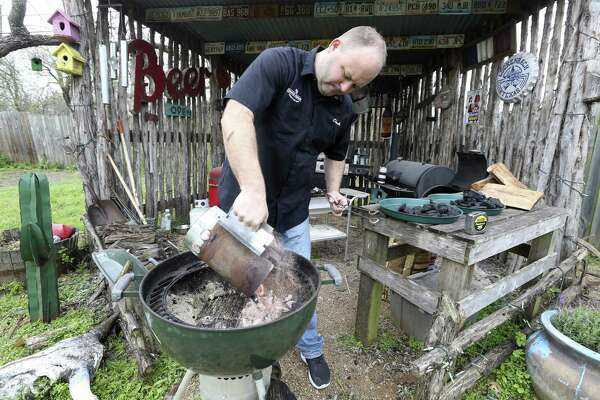Robles, a world champion barbecue cook based out of Weslaco, is the type of guy who constantly tinkers with his recipes, cooking devices, and meat preparations. He’s so precise with his demanding command of temperature, he counts the number of charcoal briquettes that are used to grill up his chicken.
“The magic number is 47,” Robles said. “That will usually get my grill to about 350 degrees, which is the temperature that will cook and finish the chicken the way I like it in about an hour.”
If you don’t want to spend hours experimenting briquette by briquette, here is a simplified formula: Take the diameter of your grill and multiply that number by two. That’s how many briquettes are needed to ballpark 350 degrees with the cover applied and your meat placed away from the hot coals.
There are other ways to take command of your outdoor fire, making the cooking process as simple and consistent as anything that could be done in a conventional kitchen oven. Here are some ways to do it:
Setup
The charcoal: You can go either the hardwood lump or the conventional briquette route. Both have key strengths and weaknesses.
The lump charcoal will burn about 5 to 10 degrees hotter than the briquettes, provides a cleaner wood flavor and won’t cook down into pure flaky ash. That makes it perfect for the caveman style of cooking directly on the coals. However, since the charcoal pieces are randomly sized (some chunks as big as a human fist), it can be a bit unpredictable.
On ExpressNews.com: Youth pitbuilders showcase their handmade pits that rival the pros at San Antonio Stock Show & Rodeo
Briquettes are of uniform size and will hold the heat a little longer, with a signature flavor that reminds everybody of the backyard cookouts they grew up with. Kingsford charcoal, the industry leader in briquette charcoal by a wide margin, is a staple on the competition barbecue circuit because of its ability to win over judges that score with a nostalgic palate.
Wood: Manny Olivo, owner of the Schertz-based Cow Tippin BBQ food truck, keeps his fire pure with pecan wood by taking the scraps, starting the fire small, and building it up into a blaze. “It take a little more time, but it’s worth it for the flavor,” he said.
Remove the bark from the logs and accumulate the shavings and scraps that can be pulled off the wood. As it burns, add larger pieces until you are burning chunks that are about the size of a rolling pin. One or two logs on a bed of coals will get a traditional off-set steel pit into that magic temperature window between 225 and 250 degrees. Avoid large logs, which have a tendency to smolder and can add a funky taste to the meat.
Ignition
Lighter fluid: It can make life easier in a pinch, but I avoid it at all costs, including the charcoal that comes coated with it. The fuel never completely burns off, and the flavor will transfer into the meat like a seasoning.
On ExpressNews.com: 1 smoker, 10 store-bought sauces. Which got smoked?
Chimney starter: The metal contraption that’s shaped like a German beer stein is the perfect vehicle for getting a good fire going. Stuff a few sheets of newspaper or a couple paper towels coated in cooking oil underneath your briquettes, light it up, and you should have a perfect blend of hot charcoal that glows like lava in about 20 minutes. A full starter will hold about 70 briquettes.
Flamethrower: Don’t laugh. This is a thing, and it’s legal. They sell open-flame devices, often marketed as a weed-killer in the garden section of your local hardware store, that hook up to a propane tank and will light the charcoal or wood in seconds.
Temperature control
The full spread: Unfortunately, too many outdoor cooks think that the proper way to set up a grill is to blanket the bottom with coals. That’s a disaster recipe for burgers that end up looking like charred hockey pucks because of out-of-control flames that erupt when the meat grease hits the coals. The heat above the coals is usually about 550 to 600 degrees, making it impossible to cook with precision outside the realm of a quick steak cook.
Two-zone setup: Stack all of the charcoal to one side of the grill for a hot and a cold zone that provides tremendous flexibility with anything put on the grates. This is the Robles method, and it should be yours, too. Put the meat on the hot zone to finish or establish blackened grill marks, but most of the cooking time should be spent on the cool side. If your cook lasts more than an hour, add eight to 10 new coals to the hot side after an hour.
Other two-zone setups promote putting the coals on the outside with a metal pan filled with water in the middle. Eh. The water does little to moisten the meat, and the end result is mostly a wasted pan.
Vent control: All nongas grills and smokers come with vents that are located below and on top of the device. They can help control the temperature, but I’ve always found it best to keep them open all the way from start to finish. Airflow gives every fire life, and it delivers a better flavor. If the fire is burning too hot or too cold, it’s probably because an error was made in the original setup.
It shouldn’t take very long for these tips to become second-nature in your outdoor grilling process. When fanning the flames, it’s always best to maintain control.
Chuck Blount is a food writer and columnist covering all things grilled and smoked in the San Antonio area. Find his Chuck's Food Shack columns on our subscriber site, ExpressNews.com, or read his other coverage on our free site, mySA.com. | cblount@express-news.net | Twitter: @chuck_blount | Instagram: @bbqdiver




